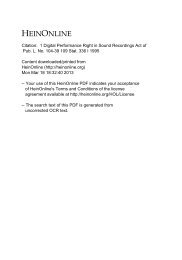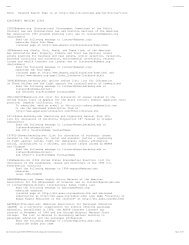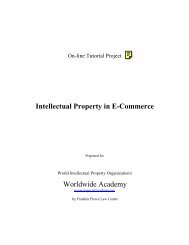BIEDERMANN MOTECH GMBH and Depuy Spine, Inc, Plaintiffs
BIEDERMANN MOTECH GMBH and Depuy Spine, Inc, Plaintiffs
BIEDERMANN MOTECH GMBH and Depuy Spine, Inc, Plaintiffs
Create successful ePaper yourself
Turn your PDF publications into a flip-book with our unique Google optimized e-Paper software.
patent, at col. 2 ll. 43-44.) That is, the specification discloses that the receiver has a lip or ridge which could<br />
have been cut from a sphere. Claim one refers to "an inner hollow spherically shaped portion." Allez would<br />
attach significance to the difference in wording. Allez argues that this means that the receiver must contain<br />
an entire sphere. (Allez Op. Br. at 15-16.)<br />
For the reasons stated in the Order of January 17, 2007, Allez's argument is rejected. (Order of Jan. 17,<br />
2007, at 12-13.)<br />
Allez responds by pointing out that many dictionaries do not include the definition of "spherical" embracing<br />
the meaning "segment of a sphere." (Allez Resp. Br. at 8-9.) However, the correctness of a definition is not<br />
negated by a party's ability to find concise, old, or bad dictionaries which lack that definition. So long as an<br />
inventor's intent is clear, he is free to use words in broader st<strong>and</strong>ard senses, even if those senses are not the<br />
most commonly used. Honeywell, <strong>Inc</strong>. v. Victor Co. of Japan, Ltd., 298 F.3d 1317, 1324 (Fed.Cir.2002). In<br />
the present patent, the inventor describes the embodiments of the invention in the clearest language,<br />
referring to spherical segments. It is immaterial that the claims lack some precision, because the claims are<br />
read in light of the specification. If an inventor can secure the approval of the patent office, the inventor is<br />
permitted to use whatever language he pleases in the claims so long as "the scope of the claim would be<br />
reasonably ascertainable by those skilled in the art." Bose Corp. v. JBL, <strong>Inc</strong>., 274 F.3d 1354, 1359<br />
(Fed.Cir.2001).<br />
So that the jury underst<strong>and</strong>s that the term "spherical" embraces the meaning "segment of a sphere," the term<br />
"spherically shaped portion" is defined as "a portion shaped like a segment of a sphere." <strong>Plaintiffs</strong>'<br />
definition is essentially the same. It reads, "a portion of a thing shaped like a sphere; it encompasses a<br />
segment of a sphere." (Pl. Op. Br. at 25.) There are two reasons the <strong>Plaintiffs</strong>' definition is not adopted.<br />
First, it refers to a "thing" in a confusing way. Second, it confuses the jury by stating that the "thing" is<br />
"shaped like a sphere," which is precisely what the <strong>Plaintiffs</strong> are arguing against! The <strong>Plaintiffs</strong>' entire<br />
argument is that they do not need to show an entire sphere, rather, a segment of a sphere will suffice. While<br />
the term "spherical" may embrace the notion of "a segment of a sphere," there is no evidence that the term<br />
"sphere" embraces that notion.<br />
C. Compression Member<br />
There are two issues regarding the interpretation of the phrase "compression member." First, is the phrase a<br />
means-plus-function limitation pursuant to 35 U.S.C. s. 112(6)? Second, if not, what is the meaning of the<br />
phrase "compression member"?<br />
If the phrase "compression member" is interpreted pursuant to s. 112(6), then according to the statute,<br />
<strong>Plaintiffs</strong> would be limited to claiming the corresponding structure disclosed in the specification <strong>and</strong><br />
equivalents thereof. In other words, Allez would like "compression member" to be interpreted as a meansplus-function<br />
limitation because <strong>Plaintiffs</strong> would be left with a narrow set of claims, making it more likely<br />
that Allez would be found not to infringe the '678 patent.<br />
The Federal Circuit has spoken directly on the issue of whether "compression member" should be<br />
interpreted as a means-plus-function limitation pursuant to 35 U.S.C. s. 112(6). The answer is no, it should<br />
not. <strong>Depuy</strong> <strong>Spine</strong>, <strong>Inc</strong>. v. Medtronic Sofamor Danek, <strong>Inc</strong>., 469 F.3d 1005, 1023 (Fed.Cir.2006).<br />
Allez argues that Judge Harrington <strong>and</strong> the Federal Circuit were mistaken for any number of reasons.






